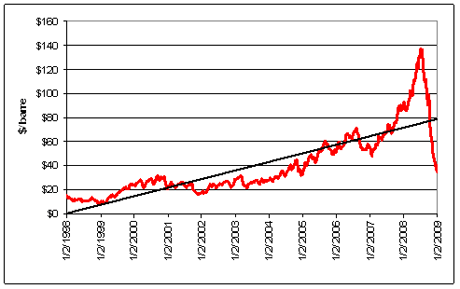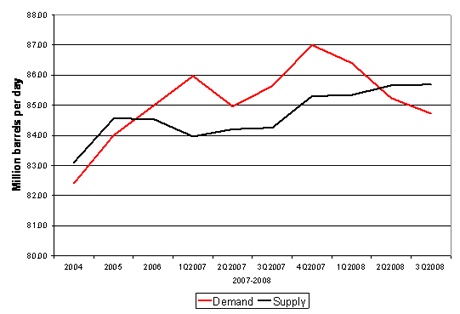| 1.23.09 | Tam Hunt, Director of Energy Programs, Community Environmental Council |
Question: Are speculators and Enron ex-employees behind oil price turbulence, as 60 Minutes recently asserted? Answer: No.
That line alone would be a tad short for an op-ed, so let me explain. 60 Minutes, the most popular and respected newsmagazine on television, devoted a segment on January 11 to dramatically declining oil prices. The show gave airtime to many commentators, all of whom argued strongly that the key factor in the run up of oil prices in the first half of 2008, and the precipitous decline since then, was oil market speculation. There was even a brief discussion of Enron's erstwhile employees and their continuing role in energy markets. The implication was that there may yet turn out to be some malfeasance in the oil price gyrations over the last few years.
60 Minutes opened the piece with a disclaimer about the complexity of the forces behind oil price movements. But then the show spent 15 minutes painting a very one-sided story about the reasons for oil price movements, with not a single dissenting view presented.
I agree that oil markets are highly complex. And I agree that at this point literally no one knows the full answer as to why markets have been on such a wild ride. But the sketch provided by 60 Minutes is only half the story, at best. The more complete analysis takes into account the fact that prices have been driven as much by supply and demand, and the perception of supply and demand, as by speculation. I'll unpack this statement below.
First, let's look at oil prices over the last decade (figure 1). As we can see, oil prices, which reflect one of the few truly global markets, have risen steadily for ten years. But from early 2007 until the middle of 2008, they surged to almost $150 a barrel. The surge went the other direction from July of 2008 until now, with oil prices again around $40 a barrel. The black trend line, however, shows that even without this spike, prices have been steadily increasing for a decade.

Figure 1. Weekly world oil price, 1998-2008 (nominal dollars, source: EIA).
So what's going on?
It's highly important to look at the global supply and demand situation over the last few years. As I already mentioned, oil is one of the truly global markets. As such, global supply and demand sets the price, not regional supply and demand. Or, to be more accurate, perceptions of global supply and demand are the most important data.
The mainstream media have done a very poor job -- including 60 Minutes -- at highlighting the fact that global oil supplies stagnated for about four years, from 2004 to the end of 2007, as Figure 2 shows.

Figure 2. Global supply and demand, 2004-2008 (source: EIA).
Global supplies only matter, however, when compared to global demand. If demand was also plateauing, or declining, at the same time as this plateau occurred, we would have had no problem with supply. But that wasn't the case. Demand was, in fact, continuing to rise. As Figure 2 shows, global oil demand rose from about 82 million barrels per day in 2004 to 86 million in 2008 -- a substantial increase.
When we look at both trends together, we see that there was a sustained period of imbalance between supply and demand, lasting, unsurprisingly, about the same length of time as the dramatic run up in the price of oil lasted (1.5 to 2 years, Figure 3). This means that global inventories of oil, both private and public, were being drawn down during the imbalance period. Obviously, such a situation could not continue. Something had to give and prices rose. And then fell, as supplies increased and demand dropped.

Figure 3. Supply shortfalls/surpluses, 2004-2008 (source: EIA).
The Energy Information Administration (EIA) is the United State's official energy statistics agency. It was cited in the 60 Minutes piece, but the information cited was used misleadingly. Yes, U.S. demand for oil and gasoline declined dramatically in the first half of 2008, and since, but as late as the first quarter of 2008, global demand was still exceeding global supply -- and had been for the previous two years. (This data is also revised, sometimes substantially, after its initial release, highlighting the fact that real-time data on oil markets is not very reliable).
Moreover, the International Energy Agency (IEA) -- the international equivalent of the EIA -- had released a report in July of 2007 warning of a pending oil supply crunch if major investments in new projects were not made. This document was publicly available, and still is. While this report, and the ongoing supply/demand imbalance were not discussed much in the mainstream media, they were discussed a great deal in professional media and more energy-oriented mainstream media like the Wall Street Journal. And many websites discussed the ongoing situation in great detail, such as www.theoildrum.com, which contains sophisticated discussions of various energy issues, including "peak oil," which is the notion that global oil supplies are at or near their peak and that supply/demand imbalances will persist and get worse over time.
This segue brings me to a broader point, regarding peak oil, Again, even though the mainstream media hasn't done a very good job reporting on this topic, some outlets ran significant articles and commentary over the last few years, including the New York Times, Wall Street Journal, Los Angeles Times, National Geographic and others. And, of course, the professional media included much discussion of the idea that global oil supplies are at or near their peak. At the same time, the EIA and IEA were releasing increasingly dire data and reports, warning of major supply crunches if new investments weren't made.
This brings me to my last point: markets function based on expectations for future profit, as well as actual need for the product. Global oil markets are not open only to those purchasing oil for their own use. As the 60 Minutes story mentions, there are traders in the market -- and lots of them. But markets don't operate for long without fundamentals to back them up. So the better story about what happened to oil prices over the last few years -- as demonstrated by the charts above -- is that global supply became very constrained vis a vis demand, stocks were drawn down, and expectations of future supply shortages dominated the market for a short time. Prices rose very high as a result. When prices became too high, economies started to shudder. As we now know, the U.S. went into recession in December of 2007, long before the credit and mortgage crises hit. As these crises hit us, global oil supplies finally started to increase again. The net result: a large run-up in prices as supply constraints worsened, followed by an even sharper drop as supplies finally started to increase and demand plummeted.
Is this the full story? No. We'll probably never know the full story, but this is a far more accurate version than the caricature provided by 60 Minutes.
So it's not just another Enron story. Rather, there are fundamentals at the root of recent oil price gyrations. The very real risk posed by blaming the oil prices on bad actors is that we miss the exceedingly serious problem of even more significant oil supply shortfalls headed our way -- peak oil. As the IEA described in its 2008 World Energy Outlook, the world needs three new Saudi Arabias of oil by 2015, and almost seven by 2030. This, to be blunt, is not going to happen. And we need to start preparing for the much higher prices and eventual shortfalls in oil that are headed our way.
The current economic crisis will give us a little more time, due to declining global oil demand, but it will make the mid-term and long-term problems even worse. This is the case because of the failure to bring new projects online that would otherwise have come online over the next few years.
The IEA report concludes: "Securing energy supplies and speeding up the transition to a low-carbon energy system both call for radical action by governments -- at national and local levels."
We might want to heed their words. Tam Hunt is Energy Program Director and Attorney for the Community Environmental Council in Santa Barbara. See www.cecsb.org for our regional energy blueprint. He is also a Lecturer in renewable energy law and policy at the Bren School of Environmental Science & Management at UC Santa Barbara.
![]()
Copyright © 2002-2006, CyberTech, Inc. - All rights reserved.